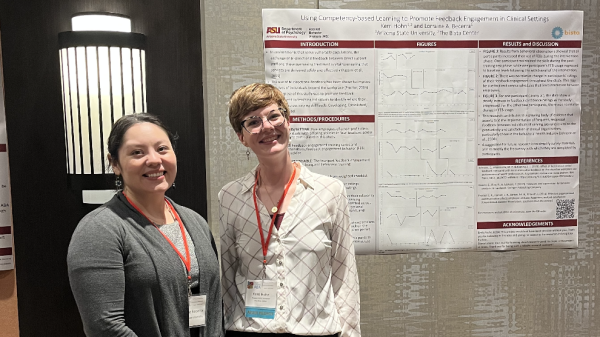ASU study tracks evolutionary transition to destructive cancer

Micrograph of Barrett's esophagus (left of image) and normal stratified squamous epithelium (right of image). Alcian blue stain identifies the characteristic goblet cells. Image: Public domain.
Evolution describes how all living forms cope with challenges in their environment, as they struggle to persevere against formidable odds. Mutation and selective pressure — cornerstones of Darwin’s theory — are the means by which organisms gain an advantageous foothold or pass into oblivion.
In a new study, researchers at Arizona State University's Biodesign Institute led an international team to explore how evolutionary processes guide the pathways of cells. Their results, which appear in the advanced online edition of the journal Nature Communications, point to influences leading some cells to remain stable over time while driving others to become cancerous and expand without limit.
The new research focuses on a condition known as Barrett’s esophagus (BE). The disease, which affects over three million Americans, causes cells lining the throat to change shape from their normal form (known as squamous epithelia) to a pathological cell type (known as columnar epithelia).
A small number of BE patients — just 0.2 percent per year — will go on to develop a highly lethal, treatment-resistant cancer, known as esophageal adenocarcinoma (EAC). Despite advances in therapy, prospects for EAC patients remain bleak — fewer than 15 percent survive beyond five years. (While the incidence of EAC in the United States has remained low, it has risen alarmingly in recent years.)
Understanding why most BE patients avoid this fate and some don’t has been a challenge for the medical community. Evolutionary oncologists like Carlo Maley, a researcher at the Biodesign Center for Personalized Diagnostics and a senior author of the new study, believe a better understanding of the evolutionary dynamics of this process may hold the key. The study examines these dynamics over at least 6 years of surveillance. Of the eight BE patients examined, four remained stable and four progressed to cancer.
“By taking a host of minute samples across the surface of the esophagus, and across many years while these patients were under surveillance to detect cancer, we had an unprecedented view of the dynamics of carcinogenesis,” Maley said.
Sensing the threat
BE presents a conundrum for clinicians. The condition is a risk factor for developing a deadly, highly intractable cancer but only a tiny proportion of BE patients will progress to cancer. Because no reliable means exist at present to distinguish progressors from non-progressors, the only cautionary measures available involve repeated surveillance of BE esophageal cells through endoscopy and biopsy to try to catch EAC-linked abnormalities at an early stage, or methods to burn away the lining of the esophagus.
Such invasive, expensive and often unnecessary screening and interventions result in overdiagnosis and overtreatment, while surveillance of esophageal cells on a population-wide basis is impractical. Clearly, a more reliable approach is needed — one that can ferret out those BE patients most likely to advance to EAC.
As the authors note, better predictions will rely in part on testing BE samples at multiple points in time, and an examination of cells extracted from different locations in the esophageal tissue. One positive consequence of aggressive BE cell surveillance is that it has provided researchers with a rich library of data that can be mined using new methods in order to tease out critical factors governing progression vs. non-progression to cancer.
Disease origins
Barrett’s esophagus can develop over time when digestive acid backs up from the stomach into the esophagus, causing damage and growth of precancerous cells. To accurately assess the evolutionary dynamics involved in progression to cancer, researchers need more fine-grained analyses of BE cells, to tease out details that may not be detectable in whole biopsies containing millions of cells.
In BE, the columnar architecture of the epithelium is similar to that of the intestine. Here, well-like structures in the tissue known as crypts appear. At the base of those crypts are stem cells, which replenish the epithelium as older cells migrate up the sides of the crypts and then die off. The study represents the first genome-wide analysis of the evolutionary dynamics in BE at the level of individual crypts. (While crypts may contain more than a single stem cell, these cells tend to be genetically uniform. For this reason, crypt sampling is closely analogous to sampling single BE cells.)
Researchers would like to know why most cases of BE appear to be evolutionarily static over time. Either genetic alterations tend to be rare or, if they are common, cells carrying those alterations do not expand to levels detectable through conventional biopsy. The new study examines the genomes of single crypts in BE to take a closer look at when and where genetic variants arise and how the evolutionary process plays out.
Ominous progression
Advancement from BE to EAC is a process characterized by mounting genomic instability. Over time, BE patients can accumulate mutations in their esophageal lesions, altering the genetic makeup of these cells. Such genetic variation is regarded as a valuable predictor of progression to cancer, though the highly complex dynamics of this process are still being worked out.
The study focused on losses and gains of large regions of chromosomes in the BE cells. Aberrations in the chromosomes are high in those who go on to develop EAC, even four years before progression and remain low in non-progressors, pointing to the value of chromosomal diversity as a diagnostic indicator.
The study also examined a phenomenon known as genome doubling. This results from faulty cell division, which creates a cell with twice the normal number of chromosomes. Those likely to progress to EAC were also more likely to experience genome doubling, which is presaged by an increasing rate of accumulation of chromosomal aberrations.
The study examines genetic variation in BE crypts, comparing these with the variation found through examination of biopsies. Multiple biopsies and crypt samples were examined from eight BE patients at two different time points. Four of these patients progressed to EAC and four did not.
Results comparing biopsy and single crypt information show that genetic alterations are indeed rare, even at the crypt level, and that Barrett’s lesions tend to arise from a single ancestral cell gone awry. Further, the study selects cells from different regions of the esophagus and finds that genetic alterations were more common in samples taken near the base of the esophagus, known as the gastro-esophageal junction.
New findings
The study addresses five previously unanswered questions concerning BE. As the authors stress, the results offer new insights into the general process of cell progression to cancer, which may be applicable across many, if not all forms of the disease.
Results indicate that:
a) BE tissue in most cases arises from a single altered ancestral cell
b) expansion of cancerous clones (identical cells of common ancestry) is rare
c) cells sampled near the gastro-esophageal junction accumulate more genomic alterations than those found in other regions of the esophagus, making them better targets for diagnosis
d) there are dramatic changes in mutation rate during progression and these may occur early in the process of cancer progression and
e) genetic diversity as measured through biopsy in Barrett’s patients is comparable to that observes in individual crypts, indicating that biopsy analysis is adequate for assessing the evolutionary characteristics of BE cells and their likelihood of progression.
Continued work in this area promises to untangle the complex network of evolutionary factors at play when cells are directed away from their normal course and toward the fateful path of cancer.
More Science and technology

Miss Arizona, computer science major wants to inspire children to combine code and creativity
Editor’s note: This story is part of a series of profiles of notable spring 2024 graduates. “It’s bittersweet.” That’s how…

ASU applied behavior analysis program recognized in Four Corners region
Helping students with learning disabilities succeed in school and modeling effective communication skills are just two examples…

50 years later, international experts discuss importance of 'Lucy' discovery at ASU symposium
“Lucy” is one of the most famous human ancestor fossils of all time. Discovered by ASU Institute of Human Origins Founding…